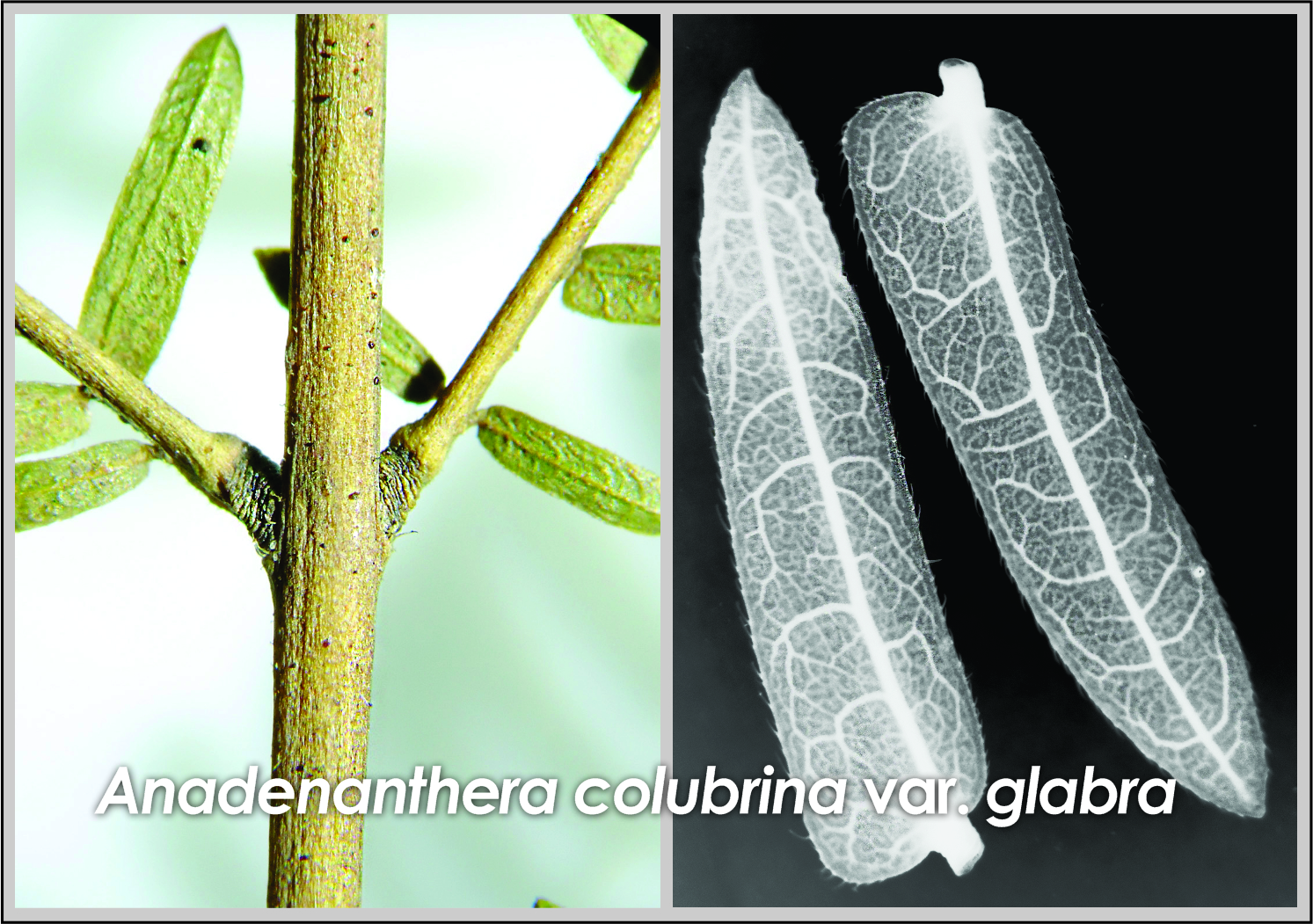Una nueva variedad de Anadenanthera colubrina (Leguminosae, Mimosoideae) de Argentina
DOI:
https://doi.org/10.31055/1851.2372.v55.n3.27348Palabras clave:
Anadenanthera, Argentina, Fabaceae, Leguminosae, , Mimosoideae, taxonomíaResumen
Introducción y objetivos: El género Anadenanthera está representado en Argentina por una única especie, A. colubrina, con dos variedades, var. cebil y var. colubrina. Estas variedades pueden ser claramente diferenciadas por el patrón de venación de los folíolos. En este trabajo se describe una tercera variedad, var. glabra, circunscripta por una combinación de caracteres de sus hojas y corteza.
M&M: Se estudiaron especímenes de CTES y MCNS, y se realizaron observaciones de campo en ambientes naturales de Argentina. Los especímenes se analizaron morfológicamente con microscopía óptica y electrónica de barrido.
Resultados: La nueva variedad glabra se distingue de las variedades cebil y colubrina por sus tallos sin mamelones, hojas con raquis glabro sobre ambas superficies o únicamente sobre la superficie abaxial, y los folíolos con una venación compleja, reticulada y cerrada. Se provee una ilustración, fotografías, un cuadro morfológico comparativo, una clave para diferenciar las variedades y un mapa de distribución.
Conclusiones: Las tres variedades de Anadenanthera colubrina, var. cebil, var. colubrina y var. glabra, habitan los Bosques Secos Estacionales del norte de Argentina, mostrando la nueva variedad una distribución restringida hacia la región nororiental del país.
Referencias
ALTSCHUL, S. von R. 1964. A taxonomic study of the genus Anandenanthera. Contrib. Gray Herb. Harvard Univ. 193: 1-65.
BFG (The Brazil Flora Group). 2015. Growing knowledge: an overview of Seed Plant diversity in Brazil. Rodriguésia 66: 1085-1113.
BURKART, A. 1987. Anadenanthera Speg. En: BURKART, A. (ed.), Flora Ilustrada de Entre Ríos. Colec. Cient. Inst. Nac. Tecnol. Agropec. 6: 481-482.
CACCAVARI, M. A. 2002. Pollen morphology and structure of Tropical and Subtropical American genera of the Piptadenia group (Leguminosae: Mimosoideae). Grana 41: 130-141.
http://dx.doi.org/10.1080/001731302321042597
CIALDELLA, A. M. 2000. Fabaceae. Mismosoideae. Mimoseae: Anadenanthera, Piptadenia, Parapiptadenia. En: HUNZIKER, A. T. (ed.), Fl. Fanerog. Argent. 67: 1-10.
DE QUEIROZ, L. P. 2009. Leguminosas da Caatinga. Universidade Estadual de Feira de Santana, Feira de Santana.
DIGILIO, A. P. L. & P. R. LEGNAME. 1966. Los árboles indígenas de la Provincia de Tucumán. Opera Lilloana 15: 1-283.
DRYFLOR (Latin American and Caribbean Seasonally Dry Tropical Forest Floristic Network). 2016. Plant diversity patterns and their conservation implications in Neotropical dry forests. Science 353: 1383-1387. https://doi.org/10.1126/science.aaf5080
GONCALVES, A. L., M. V. GARCIA, M. HEUERTZ & S. C. GONZALEZ-MARTINEZ. 2019. Demographic history and spatial genetic structure in a remnant population of the subtropical tree Anadenanthera colubrina var. cebil (Griseb.) Altschul (Fabaceae). Ann. For. Sci. 76: 1-18. https://doi.org/10.1007/s13595-019-0797-z
LEWIS, G. P. 2008. Anadenanthera Speg. En: ZULOAGA, F. O., O. MORRONE & M. J. BELGRANO (eds.), Catálogo de las Plantas Vasculares del Cono Sur (Argentina, Sur de Brasil, Chile, Paraguay y Uruguay). Monogr. Syst. Bot. Missouri Bot. 107: 2114.
LEWIS, G. P., B. D. SCHRIRE, B. A. MACKINDER & M. LOCK. 2005. Legumes of the world. Royal Botanic Gardens, Kew, London. https://doi.org/10.1111/1467-8748.00116
LPWG (The Legume Phylogeny Working Group). 2013a. Legume phylogeny and classification in the 21st Century: progress, prospects and lessons for other species-rich clades. Taxon 62: 217-248.
https://doi.org/10.5167/uzh-78167
LPWG (The Legume Phylogeny Working Group). 2013b. Towards a new classification system for legumes: Progress report from the 6th International Legume Conference. S. African J. Bot. 89: 3-9. https://doi.org/10.1016/j.sajb.2013.07.022
LPWG (The Legume Phylogeny Working Group). 2017. A new subfamily classification of the Leguminosae based on a taxonomically comprehensive phylogeny. Taxon 66: 44-77.
https://doi.org/10.12705/661.3
MARTÍNEZ, O. G., M. E. BARRANDEGUY, M. V. GARCÍA, D. A. CACHARANI & D. E. PRADO. 2013. Presencia de Anadenanthera colubrina var. colubrina (Fabaceae, Mimosoideae) en Argentina. Darwiniana nueva serie 1: 279-288. https://doi:10.14522/darwiniana.2013.12.536
MOGNI, V. Y., L. J. OAKLEY & D. E. PRADO. 2015. The distribution of woody legumes in neotropical dry forests: the Pleistocene Arc Theory 20 years on. Edinburgh J. Bot. 72: 35-60.
https://doi:10.1017/S0960428614000298
MORIM, M. P. 2015. Anadenanthera in Lista de Espécies da Flora do Brasil. Jardim Botânico do Rio de Janeiro. http://floradobrasil.jbrj.gov.br/jabot/floradobrasil/FB18071 [acceso: 26 julio 2019].
OAKLEY, L. J. & D. E. PRADO. 2011. El Dominio de los Bosques Secos Estacionales Neotropicales y la presencia del Arco Pleistocénico en la República del Paraguay. Rojasiana 10: 55-75.
PRADO, D. E. & P. E. GIBBS. 1993. Patterns of species distributions in the dry seasonal forests of South America. Ann. Missouri Bot. Gard. 80: 902-927.
PRADO, D. E. 1995. Selva pedemontana: contexto regional y lista florística de un ecosistema en peligro. En: Brown, A. D. & H. R. Grau (eds.), Investigación, conservación y desarrollo en selvas subtropicales de montaña, pp. 19-52, Universidad Nacional de Tucumán, Facultad de Ciencias Naturales e Instituto Miguel Lillo, Horco Molle.
PRADO, D. E. 2000. Seasonally dry forests of tropical South America: from forgotten ecosystems to a new phytogeographic unit. Edinburgh J. Bot. 57: 437-461. https://doi:10.1017/S096042860000041X
QGIS (Quantum GIS Development Team). 2016. Quantum GIS Geographic Information System. Open Source Geospatial Foundation Project. http://qgis.osgeo.org [acceso: 18 mayo 2019].
SALLABANKS, R. & S. P. COURTNEY. 1992. Frugivory, seed predation, and insect-vertebrate interactions. Annu. Rev. Entomol. 37: 377-400. https://doi.org/10.1146/annurev.en.37.010192.002113
THIERS, B. Index Herbariorum: a global directory of public herbaria and associated staff. New York Botanical Garden’s Virtual Herbarium, Disponible en: http://sweetgum.nybg.org/ih [Acceso: 15 noviembre 2018].

Publicado
Número
Sección
Licencia
Derechos de autor 2020 Daniel A. Cacharani, María E. Barrandeguy, María V. García, María L Costas, Olga G. Martínez, Darién E. Prado

Esta obra está bajo una licencia internacional Creative Commons Atribución-NoComercial-SinDerivadas 4.0.
El Bol. Soc. Argent. Bot.:
- Provee ACCESO ABIERTO y gratuito inmediato a su contenido bajo el principio de que hacer disponible gratuitamente la investigación al público, lo cual fomenta un mayor intercambio de conocimiento global.

- Permite a los autores mantener sus derechos de autor sin restricciones.
- El material publicado en Bol. Soc. Argent. Bot. se distribuye bajo una licencia de Creative Commons Atribución-NoComercial-CompartirIgual 4.0 Internacional.






